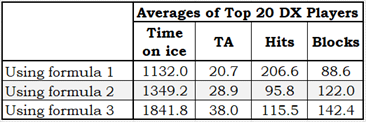Standings

Team Record by Game Type
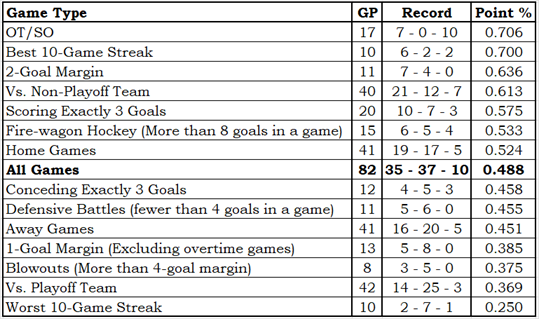
More information regarding Team Record by Game Type
The Team Record by Game Type is based on an idea I saw in a Bill James Baseball Abstract (exact year unknown; it was in an Abstract from the 1980s). It showed how a specific team did in various types of games, and it is exactly the sort of thing that I really like.
The table is sorted by point percentage (Point % column), so each team’s content order will be different and logically related game types could be well separated. Since that is the way that Bill James did it, it must be the correct way.
OT/SO is a team’s record in overtime and shootout games. These games are impossible to lose, so the loss count will always be zero. A loss is a game in which a team gets no standing points; a tie is a game in which a team gets one standing point, as they do in overtime or shootout losses.
Conceding Exactly 3 Goals and Scoring Exactly 3 Goals show how teams did in games where they scored enough to have a chance to win or conceded just enough that they could win.
1-Goal Margin, 2-Goal Margin and Blowouts (More than 4-goal margin) are for games with scores like 6-5, 6-4 and 6-1 (respectively). The 1-goal games do not include OT/SO games.
Defensive Battles and Fire-wagon Hockey are for games with scores like 2-0 and 7-3 (respectively). The entire set of Defensive Battle scores are 3-0, 2-1, 2-0 and 1-0.
Vs. Playoff Team and Vs. Non-Playoff Team are based on opponent playoff status at the end of the season, not at the time of the game. Two examples: Pittsburgh would be a non-playoff opponent and Florida would be a playoff opponent.
Best 10-Game Streak and Worst 10-Game Streak need no further explanation.
Home Games, Away Games and All Games need no further explanation.
Hide additional Information regarding Team Record by Game Type
Talent Distribution

More information regarding Talent Distribution
The Talent Distribution tables show how player talent is distributed in a team.
The Count by Category table shows how many players the team has in each of the six PR Categories, broken down by position. It is good to have PR-Elite and PR-Star players.
The PR% by Age Group table shows where the team’s productivity lies by age group. For context, it also shows the league averages.
If a team has a lot of talent in the younger age groups you would think that was a good omen for the team’s future, while if the team has a lot of talent in the older age groups that would seem to be a bad omen: old players don’t get better, they get worse.
The PR% by Draft Status shows how a team acquired the talent they have, by one of three categories: they drafted the player, another team drafted the player, or the player was undrafted. In order to provide a little context, league averages are also shown.
This information is more “how a team got their talent” than “how a team should get its talent.”
It would be nice if the players a team drafts do well and stay with the team, but it is also nice to acquire talent from other teams, and it is also nice to sign an undrafted free agent.
Hide additional Information regarding Talent Distribution
Return From Play Dollars
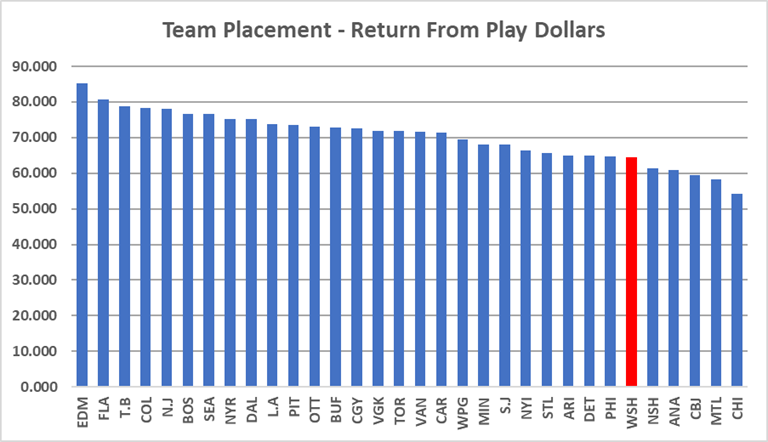
More information regarding Return From Play Dollars
Return From Play (RFP) translates a player’s Productivity Rating into a dollar amount that is loosely based on the 2021-22 salary cap. It has nothing to do with how much a player was paid: it is about how much a player was worth.
We do this sort of thing all the time. “They charged me $10 for the hamburger, but it tasted like a $30 steak.” “I bought my used car for $10,000, but it rides like a $50,000 car.” “I paid $500 a night for a hotel in Toronto; the place might have been worth $200.”
In 2022-23, Zach Hyman (EDM) was in the PR-Star category and had a PR-Score of 8.6554. His RFP was $7,040,000, based on his PR-Score. Essentially, he played like a $7-million player.
Seasonal RFPs can be added together, producing a total RFP for a player over time. Auston Matthew’s (TOR) return from play in his career is $55,920,000.
The RFP of all players on a team can be added together, telling us something about the level of talent on it. Colorado’s RFP in 2022-23 was $78,340,000, while the RFP of Columbus was $59,455,000. Colorado had the better players.
Hide additional Information regarding Return From Play Dollars
Lines and Pairs
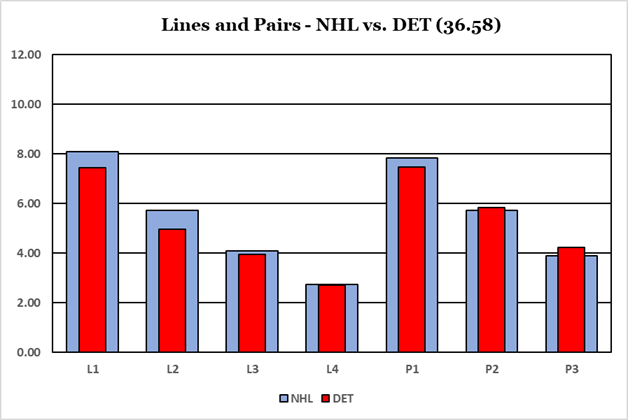
More information regarding Lines & Pairs
The Lines and Pairs section consists of the chart above and the table below. The chart shows where the team’s talents are in comparison to the league average, while the table shows which players are on which forward line or which defensive pair.
Players are sorted by team, by position and by their PR-Score. Traded players will use have their PR-Score apportioned based on how many games they played with each team. A player who played 50 games with one team and 25 games with a second team will be assigned 2/3 of his PR-Score for the team he played 50 games for, and 1/3 of his PR-Score for the team he played 25 games for.
The top three forwards are identified as the first line, the next three as the second line, and so on. There is no guarantee that any line has actually played even one second together during the season: the lines and pairs are solely based on productivity rating.
There are times when a player who was traded at the trade deadline will appear on the L&P table for both teams he played for. That just means that he was one of the top twelve forwards (or top six defensemen) for both teams, based on the statistics he accumulated with each team.
Hide Information regarding Lines & Pairs

Team Leaders – Stapled To The Bench Categories

More information regarding Team Leaders – Stapled To The Bench Categories
The Team Leader table identifies the best player on the team in six Stapled To The Bench categories. I will not go into the formulas used.
- The Most Productive player is the player with the highest PR-Score.
- The Most Valuable player is the player with the highest VR-Score.
- The Best Center is the player who was their team’s most highly rated center.
- The Most Disruptive player is based on blocked shots, hits and take-aways.
- The Best Power Player is based on both individual and team statistics that comes from powerplay time-on-ice.
- The Best Penalty Killer is based on statistics that comes from short-handed time-on-ice.
Hide additional Information regarding Team Leaders – Stapled To The Bench Categories
Team Leaders – On-Ice Situations
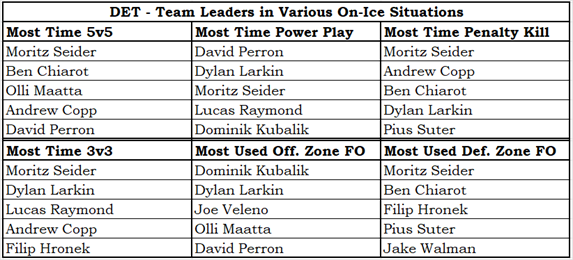
More information regarding Team Leaders – On-Ice Situations
- The Team Leaders for various On-Ice situations table shows the players who got the most ice-time in certain situations.
- In the time categories, players are ranked by ice-time (in minutes played) over the season, not on ice-time per game played.
- A player who is normally heavily used in a certain situation but who missed a non-trivial number of games could fall out of the top five for his team.
- The two non-time categories show players ranked by the percent of their shifts that started in offensive or defensive zones.
- While I normally prefer to use actual counts, it seemed correct for these two categories to use percentages, provided they played a minimum number of minutes during the season.
- A minimum-time criteria avoids avoid identifying a player who played one or two games during the season as being one of the most heavily used offensive zone or defensive zone players.
Hide Information regarding Team Leaders – On-Ice Situations
Team Essay – Disruptive Players
Let me talk a little bit about the Disruption Index.
I wanted to have a statistic which reflected a player’s defensive skills with respect to interfering with the offensive efforts of his opponents. I created an index using three statistics: takeaways, hits and blocked shots. I decided to call the resulting statistic Disruption Index instead of Interference Index because I prefer DX to IX or II.
Because I know there are teams whose home hit totals are wildly different from their road hit totals, only data from road games are used. In order to have a good amount of data for evaluating players, I used data from the last three seasons. Finally, to qualify for DX a player has to meet two time-on-ice requirements. They must have played at least 328 minutes on the road in 2022-23, and at least 864 minutes on the road since 2020-2021.
Without going into the details, I multiply takeaways, hits and blocked shots by individual weights, add the multiplied numbers together to get DX-Points, then divide DX-Points by time-on-ice and multiply by 60 to create DX-Score (DX-Points per 60 minutes of play).
The DX-Rating are categories defined by DX-Score ranges: DX-A means DX-Score is greater than 30.0.
For either of you who have read my earlier work, I must admit that I changed the DX formula this season (I adjusted the weights). I found the results of the original DX formula overvalued players who do little but deliver hits and who get a limited amount of ice-time.
Under the old DX formula, the top 20 disruptive players averaged 1,132 minutes of ice time, 21 takeaways, 89 blocked shots and 207 hits. With the new and improved DX formula, the top 20 player averages were 1,349 minutes of ice time, 29 takeaways, 122 blocked shots and 96 hits.
As a final note on the formula, DX could be influenced by a team’s offensive strength. In order to have a takeaway or block a shot the opponent has to have the puck, so if your team has the puck most of the time, you aren’t getting a chance to accumulate blocked shots and takeaways.
All of this is a prelude to a short discussion focusing on Jake Walman, who I must admit I had never heard of before his name floated to the top of Detroit’s DX ratings. He was also the fifth highest rated player in the NHL.
Walman started his playing career in St. Louis and was traded to Detroit in 2021-22. His career Productivity Rating chart shows constant improvement in his four seasons.
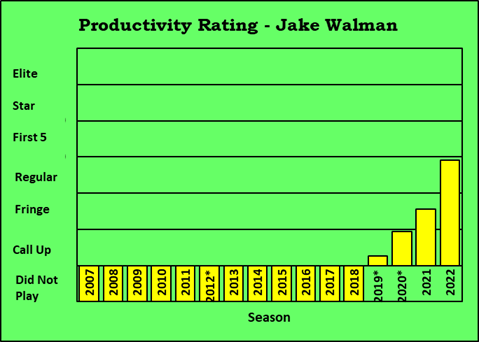
His career GP and MPG (games played and minutes per game) chart shows he has been getting more games and ice-time each season.
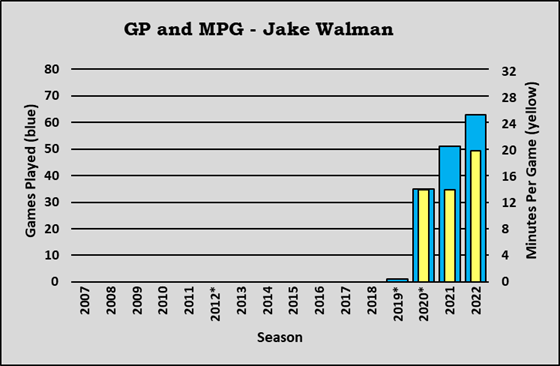
How does a defenseman who played 20 minutes per game and only played a little over 60 games last season manage to be considered the fifth-most disruptive player in the league? It is because the formula is flawed.
Here’s a quote from earlier in the article that highlights the flaw: “then divide DX-Points by time-on-ice and multiply by 60 to create DX-Score.” I thought that dividing the DX-Score by time-on-ice would put all players on an even footing, without considering just how much different their time-on-ice could be.
While Walman is 5th in the NHL in DX-Score, he is 114th in DX-Points. Only four of the top ten players in DX-Score are also in the top ten in DX-Points, while the other six aren’t in the top 50.
I will almost certainly change the DX formula next season. Without dividing by time-on-ice, the most disruptive player in Detroit is Moritz Seider, whose takeaway-block-hit numbers (24-105-142) are obviously better than Walman’s (23-98-63).
Let’s end the article with a look at the average statistics generated by the top 20 DX players based on the old formula (formula 1), the current formula (formula 2) and the probable future formula (you can figure out which one it is).
